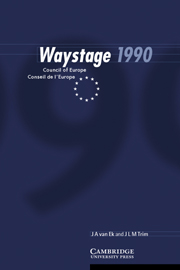Book contents
- Frontmatter
- Contents
- Preface
- Introduction
- 1 The objective: description
- 2 Components of the specification
- 3 Language functions
- 4 General notions
- 5 Themes and specific notions
- 6 Dealing with texts: reading and listening
- 7 Writing
- 8 Sociocultural competence
- 9 Verbal exchange patterns
- 10 Compensation strategies
- 11 Learning to learn
- 12 Degree of skill
- APPENDICES
3 - Language functions
Published online by Cambridge University Press: 01 March 2010
- Frontmatter
- Contents
- Preface
- Introduction
- 1 The objective: description
- 2 Components of the specification
- 3 Language functions
- 4 General notions
- 5 Themes and specific notions
- 6 Dealing with texts: reading and listening
- 7 Writing
- 8 Sociocultural competence
- 9 Verbal exchange patterns
- 10 Compensation strategies
- 11 Learning to learn
- 12 Degree of skill
- APPENDICES
Summary
Introduction
In the present specification the language functions – what people do by means of language – are listed in six broad categories:
imparting and seeking factual information
expressing and finding out attitudes
getting things done (suasion)
socialising
structuring discourse
communication repair
The second category is the most comprehensive and is subdivided as follows:
2.1–2.4 factual: agreement, etc.
2.5–2.6 factual: knowledge
2.7–2.15 factual: modality
2.16–2.20 volitional
2.21–2.29 emotional
2.30–2.35 moral
The lists of functions under each category heading are the result of a two-step process of selection. The first step produced the list in Threshold 1990 and the second step the present specification. The principle of selection has been throughout that the functions selected should meet the most likely and urgent needs of the learners and together they should be manageable within the estimated average learning time stated for the objective (see section 5 of the Introduction). In many cases exponents – sometimes even all the exponents of a function – are followed by the symbol ® (i.e. ‘for receptive use only’). This symbol is used to indicate that a particular exponent, though likely to be encountered in contact with native speakers, is felt to be of lower priority in the learners' productive repertoire.
Language functions may be fulfilled directly and indirectly. They are fulfilled directly if an exponent is used in its conventional meaning, i.e. in the meaning that would normally be assigned to it if it were used in isolation.
- Type
- Chapter
- Information
- Waystage 1990Council of Europe Conseil de l'Europe, pp. 15 - 21Publisher: Cambridge University PressPrint publication year: 1999

